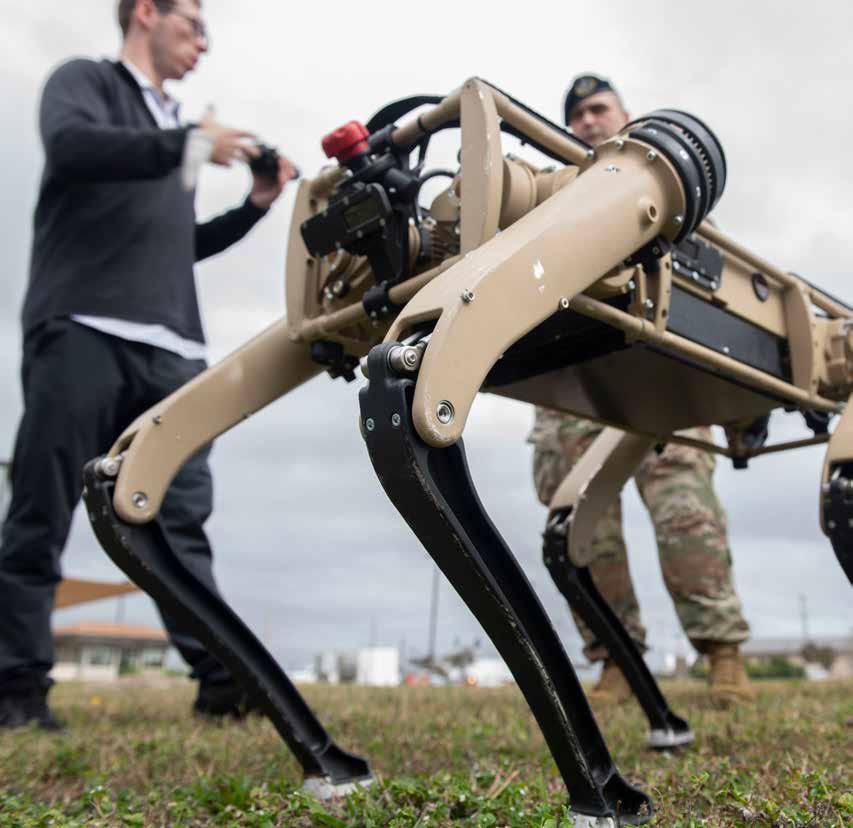
6 minute read
EDUCATION
Bay District School's New State-ofThe-Art STEM Curriculum
by: Sharon Michalik, Director of Communications, Bay District Schools
Since the inception of formal education, schools have been associated with reading, writing and arithmetic (the proverbial three Rs), but Bay District Schools (BDS) is thrilled to be adding another “R” with the inclusion of robotics classes at all levels.
Recently, the District was able to purchase a state-of-the-art curriculum program known as Woz Ed. This Science, Technology, Engineering and Math (STEM) education program designed by Steve Wozniak (one of the co-founders of Apple Computers), is focused on teaching students the “soft” skills they need to be lifelong learners and collaborators. With a focus on problem solving and critical thinking, Woz Ed students also garner some very real, and marketable, skill sets like coding, creating artificial intelligence and flying drones.
While BDS would love to roll out something like this for all students, at all schools, district leaders had to be thoughtful about the placement of the program at schools where they knew there were teachers ready to tackle these highly-technical lessons and technology. So, this year, students at Callaway, Hiland Park, Hutchison Beach, Lucille Moore, Merriam Cherry Street, Northside, Parker and Tyndall Elementary schools will have access to these courses.
Teachers in those schools have been equipped with a variety of tools like 3-D printers, Drones, Block and Text Coding tools, Robots and Cyber Security simulations. According to the Woz Ed program, their curriculum “is a convergence of the worlds of education and work. Our programs are aligned with the emerging global economy – rich with technology, driven by industry demands and infused with entrepreneurial spirit.”
The entrepreneurial spirit is alive and well throughout Bay District Schools, according to Career and Technical Education (CTE) Coordinator, Beth Patterson. “We are prepping students for the workplace but also for life,” she said. “CTE teaches soft skills, the ones you need on the job market but the ones that are also useful at the college and university level. We’re focused on looking at what students need to graduate and making sure we provide them with as many opportunities as possible.”
For example, she said, BDS middle and high school students are getting their hands on VEX robots in their science and engineering classes. “We hope, perhaps as early as next year, to be able to take our students onto the highly-competitive robotic competition circuit,” Patterson explained.
Breakfast Point Academy Principal Clint Whitfield said technology and robots are woven throughout the curriculum at his school. “Our students have built one Lego robot and two VEX robots,” he said. “After the students have the chance to test and refine their robots, we’re constructing obstacle courses for the robots so students can master the controls and programming skills needed to operate robots in the real world.”
All coding classes, he said, “use the Scratch block coding website from MIT to build understanding of coding.” Students also “use Tinkercad which is a part of Autocad for 3D printing.”
Throughout the district, CTE programs continue to grow exponentially from 61 industry certifications earned by BDS students in 2011 to 1,390 submitted to the state for verification and payment in 2020. This growth was achieved despite a Category 5 hurricane in 2018 and pandemic-related school closures in March of 2020. According to Patterson, 4,898 industry certifications were earned by students in the last five years.
Currently, one of the most popular CTE courses is Applied Cyber Security. In this program, students learn a plethora of real-world skills, according to teacher Patrick Hair, and have the opportunity to turn that education into industry certifications designed to help them both find jobs in the field and/or apply to rigorous college and university programs. “Our students are learning about the tools and systems used to monitor, mitigate, and prevent online threats,” Hair explained.
Hair, who teaches at A. Crawford Mosley High School and is their 2019-2020 Teacher of the Year, added that his students are learning about “computer hardware and software, networking basics, types of security threats, and various topics to prepare them for a career in cybersecurity.” Currently, students in these classes are working towards the “CompTIA IT Fundamentals industry certification, the first in a series of cyber-related certifications,” he added.
Patterson noted that CTE programs are not just for those seeking an alternative pathway to college. “Our rigorous, state-of-the-art CTE programs provide students the background and skills they need to be competitive at the college and university level,” she said, “as well as ensuring that students who are looking for a direct pathway to training at Haney Technical Center have what they need to be successful.”
It’s a common misconception, according to Patterson, that CTE students are “vocational” or are not planning to attend college. “To be candid,” Patterson said, “students can take some of these industry certifications and turn them into career opportunities that are very lucrative but many industry certifications are also recognized at the college level and can help our students access advanced coursework.”
Another very popular STEM program for BDS is the Drone program, according to Patterson. “Drones are just becoming a ubiquitous part of our society,” she said. “Amazon is using them, companies are using them in bigger cities to deliver food, farmers are using them to check on crops and power companies are using them to check thousands of miles of lines at a time.”
Last summer, BDS celebrated the first student who completed this rigorous process. Michael Hipskind, a Bay High graduate who entered the Army in June of 2020, passed his FAA 107 Certification to fly drones as part of Bay High’s dual-enrolled JROTC drone program with Embry Riddle University. By passing the FAA certification exam at Haney, Michael became the first BDS CTE Licensed Drone Pilot. “I believe that Michael is just the first of what will be a long line of certified drone pilots graduating from our schools,” Patterson said. “I am excited for the opportunities these students will have, and for the myriad of ways in which they can use these certifications out in the world.”
At the middle school level, CTE is alive and well with several middle school students actually completing high school level work.
Whitfield noted that BPA has “87 students in our CTE Digital Media Program of those 10 earned Spreadsheets certification.” Additionally, 55 students earned Cyber Security certification during the first quarter of this year which compares to a total of 52 students for the 2019-2020 school year.
“Sixteen BPA students are enrolled in a high school Digital Media class and they should be completing their industry certification test shortly, “ Whitfield said. High school course code students will also be learning about drones this spring and will have the opportunity to learn how to operate them efficiently.
All of these programs come with hefty price tags but BDS recently received a $167,000 infrastructure grant, part of the CARES Act funds to provide new heavy equipment construction simulators and drone equipment at J.R. Arnold High School, new welding equipment for Rutherford High School and a computer lab at North Bay Haven. The district also plans to apply for several large grants to ensure the new STEM Building at Bay High School will feature state-of-the-art allied health equipment and other technological components not typically funded by state construction dollars.
“While there’s always room for improvement, I have to say that I feel really good about the diverse offerings we have in our CTE program,” Patterson said. “We have some excellent teachers who are passionate about their work and I’m so glad our students can learn from these experts.”
All secondary students, she noted, have access to several different CTE classes, industry certifications and career pathways at their schools. Parents who are interested in finding out more about the CTE options at their child’s school are encouraged to check out the dedicated website at https://www.bay.k12.fl.us/cte-2 or speak to the child’s guidance counselor.






